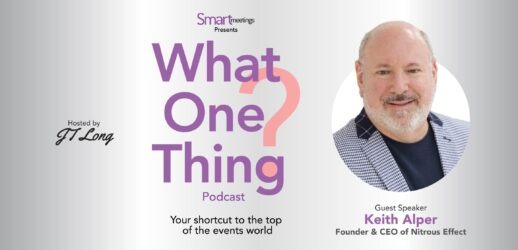How to harmonize multiple teams for amazing results
To elevate the attendee and presenter experience, you need to create a solid partnership between production, creative and program managers. Building that relationship is critical, even if it’s built in the pressure cooker of event planning.
Picture it like a three-legged stool with the event experience as the key component. Each “leg” needs to work well independently, but also together. When we have a line of sight to understand what each person is doing and why, it creates a harmonious relationship that meets our clients’ needs.
The first leg of the stool is the creative team. They dive deep to understand the client’s goals, key messages and audience mindsets. They delve into the emotions (how do you want people to feel?) as well as logistical components: who will be on stage, for how long, is it a panel discussion versus a podium parade.
Next comes production. They focus on timing and execution including, audio-visual requirements, assembling the team, technical details, budget parameters—whatever it takes to turn concepts into reality.
Program managers complete the stool. They connect the client to the event by being partially “behind the scenes” while also “front of house,” to use theater metaphors.
Each part has to trust the other without duplicating knowledge or functions.
Smooth Synergy for Amazing Events
Given that each component needs to rely on the other and share information without overlapping, what’s the most effective way to work together?
Read More: Four Crucial Questions To Ask When Developing an Effective Contingency Plan for Events
Start with the Why: Understanding the strategy isn’t limited to the creative team. Everyone involved needs to understand the fundamental “why.” Why are people coming to the meeting? Why does the client feel the need to hold an event? Why would the audience care? It’s not about decor and environmental design and amazing shows. Events at their core are vehicles for emotion designed to spark action. If every team member stays focused on the core purpose that knowledge acts as a guide for every decision by keeping the team focused on the strategy.
Practical tip: Be part of the conversation. Even if the team is talking about something that isn’t directly relevant to you, if it relates to the “why,” soak that up.
Share & Care: Know each other’s intent, rather than just knowing what the assignment is. If production is concerned about timing and budget, we can adjust creative. If creative is transparent about the message that needs to be conveyed and what the hot buttons are that could block it, production can help express the message. It goes beyond sharing information with each other to trusting that your team members have strategic intent.
Practical tip: Fight the urge to say “no” or “because we’ve always done it that way.”
Get Over Yourself: Sharing information can only go so far if one person or one team thinks their way is the only way. If creative develops a vision that blows the budget and ignores the timeline, that doesn’t lead to success. If production insists on a room layout that stifles the show, even if it’s on budget and meets deadlines, that won’t work either. If planners don’t share key information from the client (“They just went through a round of lay-offs; don’t do anything that looks expensive!”), the entire event can easily backfire. No one person, and no one team, can create and run a successful event without the others.
Practical tip: Think of it like a choir. Harmony comes from the blend of different voices.
From Theoretical to Practical: A Real-life Example
When you trust each other, and you’re focused on the client’s goals, you can be agile and adaptable. We were onsite with one of our clients when they decided that they needed a comedic video to open their awards ceremony. Eric, as Creative Director, quickly wrote a script and came to production with a list of things he would need to make it happen—a limo, a big decal with logo, wardrobe and a camera crew.
The executive producer pulled it all together, including juggling complex executive schedules, within mere hours. The video was a big hit and the client was overjoyed. The smooth execution was only possible because we trusted one another and both teams understood the client’s goals and the vision for the event.
—
Tara Rezen, CMP, brings more than 20 years of experience to her role as Bishop-McCann Executive Producer.
Eric Olson has worked as a corporate events Creative Director for more than 20 years. He has worked with some of the world’s top brands including Google, Target, Expedia Group, Medtronic and UnitedHealth Group.
This article appears in the September 2023 issue. You can subscribe to the magazine here.




